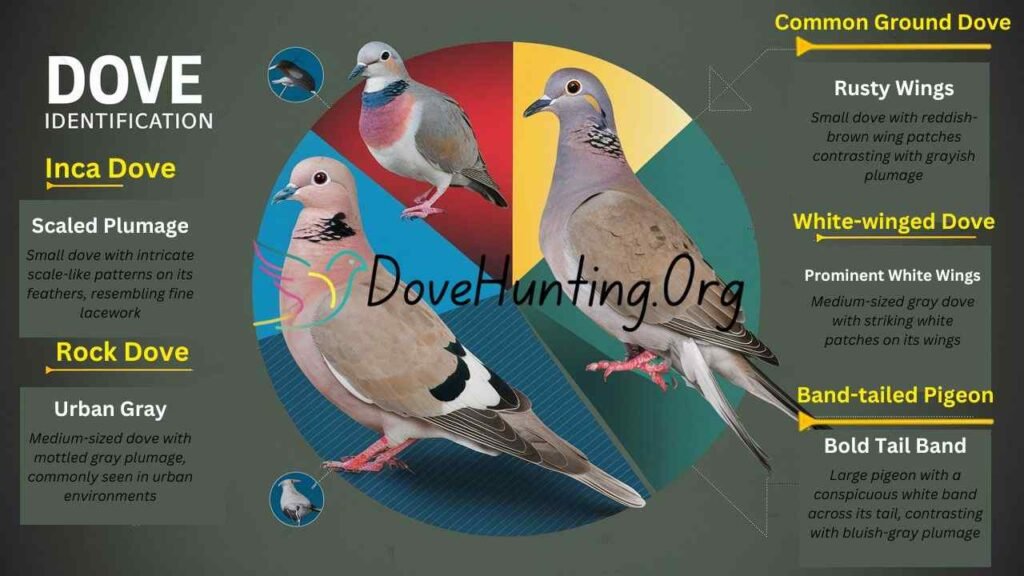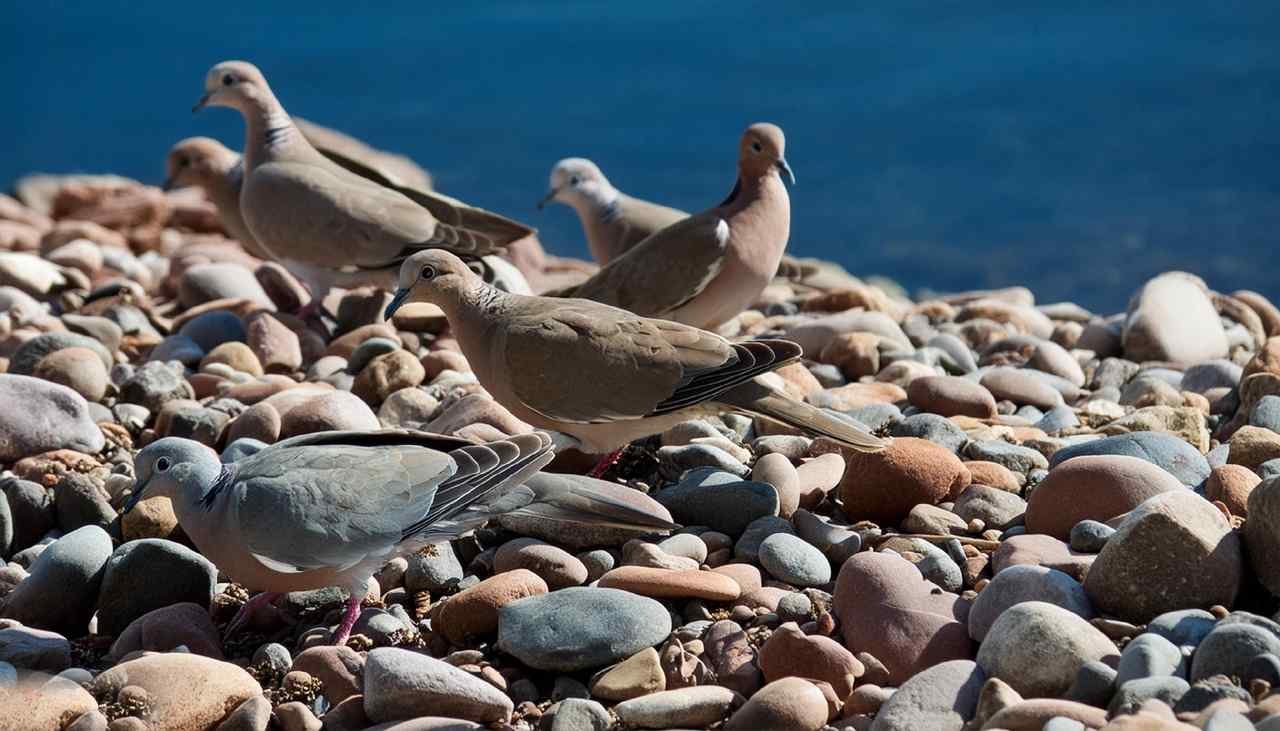Imagine sipping your coffee and spotting a unique dove, different from the regular ones. It could be smaller, perhaps with a dash of white. North America hosts a variety of doves throughout the season, often unnoticed. Their features and behavior are hard to spot. This guide can help you recognize such birds, adding a spark to your routine birdwatching.
Common Doves of North America
| Species | Size (compared to mourning dove) | Habitat | Distinguishing Features | Call |
|---|---|---|---|---|
| Mourning Dove (Columba livia) | Reference | Open woodlands, fields, suburbs | Plump body, long tail | Mournful coo (two mournful notes) |
| Inca Dove (Columbina inca) | Smaller | Deserts, arid scrublands | Rufous wash on neck, contrasting dark and light brown plumage | High-pitched, rapid coo |
| Common Ground Dove (Columbina passerina) | Smaller | Open fields, meadows, grasslands | Scaled nape, short tail, subtle brown and buff coloration | Soft, mournful coo |
| White-winged Dove (Zenaida asiatica) | Medium | Deserts, oases, scrublands | Striking black and white wing patches, long tail | Mournful coo (longer and more drawn-out than mourning dove) |
| Rock Dove (Columba livia) (Wild) | Similar | Rocky cliffs, mountains | Similar to urban rock dove, but plumage may be duller | Mournful coo (deeper and less drawn-out than mourning dove) |
| Band-tailed Pigeon (Patagioenas fasciata) | Larger | Coniferous forests, woodlands | Plump body, long tail, iridescent neck feathers, hidden crest | Loud, mournful coo (echoes through forests) |
Beyond the Mourning Dove: A Guide to Common Look-Alikes
The mourning dove (Columba livia) is a familiar sight across most of North America. Recognizable by its plump body, long tail, and mournful cooing call, it serves as a helpful reference point for identifying similar-looking dove species.
- The Inca Dove (Columbina inca) – A Shadow in the Sun: While superficially similar to the mourning dove, the Inca dove (Columbina inca) is noticeably smaller, with a rufous wash on the neck and a distinctive, high-pitched cooing call. Often found basking in sun-dappled clearings or perched on fence posts, these tiny doves can be surprisingly bold, readily approaching feeders for scattered seeds.
- The Common Ground Dove (Columbina passerina) – The Busy Body on the Ground: Unlike the mourning dove, which prefers perching on branches, the common ground dove (Columbina passerina) is a true ground dweller. See this small dove hustle across open grounds and fields. Its patterned neck and brief tail help identify it. Their soothing, sorrowful call signals their presence.
Venturing West: Doves of the Arid Regions
The arid regions of North America offer a unique habitat for several fascinating dove species.
- The White-winged Dove (Zenaida asiatica) – Flash of White in the Desert: A true showstopper, the white-winged dove (Zenaida asiatica) is a stunning desert resident. Easily identified by its striking black and white wing patches and long tail, this medium-sized dove frequents desert oases and scrublands. Keep an ear out for its mournful cooing call, a sound that carries surprisingly far through the dry air.
- Common Ground-Dove (Columbina passerina) – A Lookalike in a Different Landscape: Interestingly, the common ground dove, previously encountered in the eastern regions, also makes its home in the arid landscapes of the west. While their overall appearance remains similar, some populations exhibit slight plumage variations, making field guides and online resources invaluable for precise identification.
Northern Intrigue: Doves of the Coniferous Forests
While doves are often associated with warmer climates, a few remarkable species thrive in the cooler coniferous forests of North America.
- The Rock Dove (Columba livia) – The Urban Dove with a Wild Side: Most people are familiar with the rock dove (Columba livia), the ubiquitous “city pigeon.” However, this adaptable dove also has a wild counterpart that inhabits rocky cliffs and mountainous regions throughout North America. While the wild rock dove shares a similar appearance to its urban cousin, its plumage may be slightly duller, and it tends to be more wary of human presence.
- The Band-tailed Pigeon (Patagioenas fasciata) – A Large Dove with a Hidden Crest: The largest dove species regularly found in North America, the band-tailed pigeon (Patagioenas fasciata) is a majestic bird often mistaken for a hawk in flight. Easily distinguished by its plump body, long tail, and iridescent neck feathers, this impressive dove also possesses a hidden crest that fans out during courtship displays. Listen for its loud, mournful cooing call, a sound that echoes through the dense forests.

Tips and Tricks for Identifying Lesser-Known Doves
Now that you’ve been introduced to some of North America’s hidden dove gems, here are a few practical tips to help you identify them in the field:
- Pay Attention to Size and Shape: Compare the size of the unknown dove to familiar species like the mourning dove. Look for distinctive body shapes, such as a long tail (white-winged dove) or a plump body (band-tailed pigeon).
- Observe Coloration and Markings: While the overall plumage of many lesser-known doves may appear drab at first glance, closer observation often reveals subtle differences. Focus on unique markings like wing patterns (white-winged dove) or breast coloration (Inca dove).
- Listen for Calls and Vocalizations: Doves are known for their cooing calls, but each species has its own unique sound. The mourning dove’s mournful coo is a familiar sound, but the Inca dove’s call is higher-pitched and faster, while the common ground dove’s coo is softer and more subdued. The white-winged dove’s coo is longer and more drawn-out compared to others. Familiarizing yourself with these vocal variations can be a powerful identification tool.
- Utilize Field Guides and Online Resources: Invest in a reputable field guide specific to your region. These guides provide detailed descriptions, illustrations, and range maps for all dove species. Complement your field guide with online resources that offer high-quality bird calls and side-by-side species comparisons. The Cornell Lab of Ornithology is a great place to start your online exploration.

| Resource | Benefits | Examples |
|---|---|---|
| Field Guides | Detailed descriptions, illustrations, range maps | National Geographic Field Guide to Birds of North America, Sibley’s Birds of Western North America |
| Bird Call Websites | Listen to recordings of dove calls | Xeno-canto |
| Online Species Comparisons | Side-by-side comparisons of similar dove species with photos and key identification points | Audubon Society, Birds of North America Online |
Beyond Identification: Appreciation for Dove Diversity
Doves play a crucial role in North American ecosystems. They primarily feed on seeds and fruits, helping to disperse plant life across vast areas. Additionally, they are prey species for a variety of raptors, playing a vital role in the food chain.
Citizen science initiatives like the North American Breeding Bird Survey (USGS North American Breeding Bird Survey) rely on birdwatchers to monitor bird populations, including doves. By submitting your bird sightings, you can contribute valuable data that helps scientists track population trends and identify conservation needs.
Beyond their ecological importance, doves offer a unique aesthetic experience. Their graceful flight patterns and soft cooing calls add a touch of serenity to any natural environment. Taking the time to appreciate the subtle beauty of lesser-known dove species can enrich your birding experience and foster a deeper connection with the natural world.
Conclusion
So there you have it! North America’s dove species, often overlooked, offer a captivating world of avian diversity waiting to be explored. From the tiny Inca Dove basking in sun-dappled clearings to the majestic Band-tailed Pigeon soaring through coniferous forests, each dove possesses unique characteristics and plays a valuable role in the ecosystem.
With sharp eyes, and using these helpful hints and resources, your backyard birdwatching can turn into a thrilling discovery journey. Don’t ignore that gentle cooing noise next time. Just pause a bit and point your binoculars towards it, to embark on your own fascinating journey into the world of North American doves!

